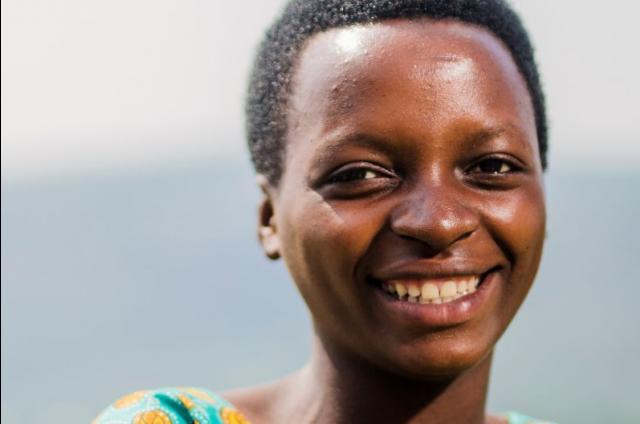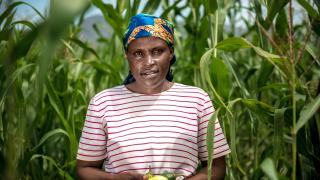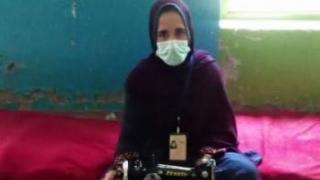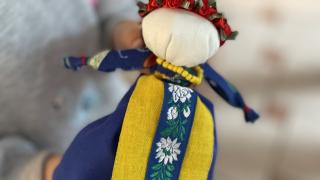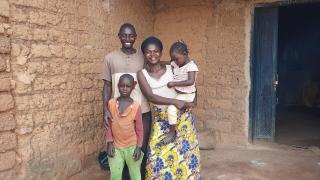10 Top Highlights: Counting Our Sisters in the Global Goals
TO ACHIEVE THE SUSTAINABLE DEVELOPMENT GOALS, GENDER EQUALITY IS NON-NEGOTIABLE. OUR DATA SHOWS HOW INVESTING IN HOLISTIC PROGRAMMING THAT LISTENS TO THE MOST MARGINALISED WOMEN TRANSFORMS THE ENABLING ENVIRONMENT FOR WOMEN’S RIGHTS.
At Women for Women International, we are committed to amplifying the voices and experiences of women survivors of war and conflict.
The daily realities of the women who enrol in our programmes are unlikely to be captured in official, national-level data. And without this data, it is hard to have a full and clear picture of our global progress toward achieving the United Nations' Sustainable Development Goals (SDGs) – 17 goals that act as a "shared blueprint for peace and prosperity for people and the planet, now and into the future".
Since 2017, we have been publishing our annual monitoring and evaluation data, collected from our programmes and the women serve, to share how our work contributes to achieving these goals.
By making our analysis of this data publicly available, we highlight the realities for women before they enrol in our year-long Stronger Women, Stronger Nations programme, as well as the progress they have made by graduation. Our data also demonstrates that tracking progress to achieve gender equality, particularly in conflict settings, requires measuring changes across a range of indicators – including food security, income, employment, education, and conflict prevention and response.

1
The Sustainable Development Goals cannot be taken in isolation
Building an enabling environment for women’s rights must be inclusive of every pillar of a woman’s experience, considering a range of issues – from food security and education to economic power and violence prevention.
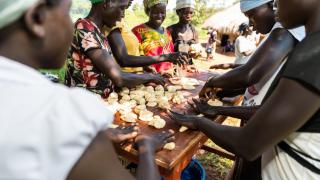
2
INVESTING IN HOLISTIC PROGRAMMING CAN MITIGATE FOOD AND ECONOMIC INSECURITY
Throughout 2021 in the Democratic Republic of Congo (DRC), South Sudan and Afghanistan, we saw parallel increases in reductions in food shortages and increases to women’s savings.
These figures for women reporting gradual increases to earnings – from 0% to 75% for Afghanistan, from 68% to 82% for the DRC and from 23% to 80% for South Sudan – correlate with women reporting gradual increases to improved food security from enrolment to graduation in the DRC (from 15% to 57%), South Sudan (from 5% to 70%) and Afghanistan (from 82% to 96%).
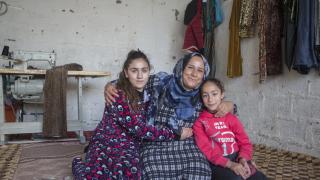
3
50% of girls enrolled in school is not enough
In conflict-affected countries, vulnerabilities are exacerbated. Education is a priority for women enrolled in our programmes and in almost all of the contexts that we work in, over 50% of girls associated with our programme are in school. But this is not enough. Over 54% of the world’s out-of-school girls live in crisis-affected places.
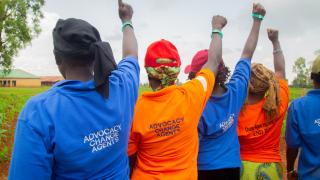
4
WOMEN CONTINUE TO DISCUSS COMMUNITY ISSUES WITH EACH OTHER. THEY LISTEN TO AND MAKE WOMEN VISIBLE WITHIN THEIR OWN SPHERES OF INFLUENCE
External barriers including increased insecurity, harmful social norms and COVID-19 limit women’s capacity to speak out publicly against violence. In the DRC, South Sudan, Nigeria and Rwanda, less than 29% of women, on average, are actively speaking out against abuse. Despite this, the number of women discussing community issues with each other remains high, at 100% of women in the DRC, 94% in South Sudan, 63% in Afghanistan and 61% in Nigeria.
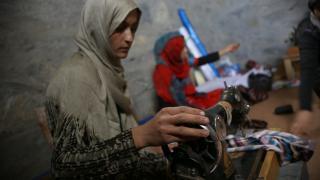
5
OUR FINDINGS EMPHASISE THE LONG-TERM SECONDARY IMPACT OF COVID-19 ON EMPLOYMENT FOR WOMEN
The percentage of women employed at graduation from 2019-2021 in the DRC declined from 93% in 2019 and 2020 to 72% in 2021. The percentage of women employed also declined between 2020 (78%) to 2021 (68%). Similarly, in South Sudan, the number of women reporting employment declined between enrolment and graduation (83%-73%). Both the DRC and South Sudan experienced COVID-19 lockdowns throughout 2021, the impact of these lockdowns prevented women from accessing work which is visible in the clear declines in relative employment in South Sudan and the DRC.
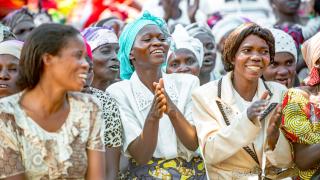
6
When the impacts of COVID-19 and conflict combine, they threaten the enabling environment for women’s rights in the DRC
Throughout 2021, the activity of local armed groups in the DRC was on the rise, increasing tensions. There were also COVID-19 lockdowns over the course of the year. Across all our indicators between 2020 and 2021, we note declines in progress at graduation for women in the DRC. For example, in 2020 – after graduating from our Stronger Women, Stronger Nations programme - 99% of women reported saving their earnings in comparison to 72% in 2021. Similarly, for women reporting earning above $1.90 a day, this percentage dropped from 61% at graduation in 2020 to 48% in 2021.
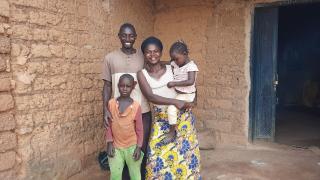
7
INVESTING IN THE POWER OF WOMEN IN NIGERIA MITIGATES AGAINST THE EXTERNAL BARRIERS OF CONFLICT AND INSECURITY THAT RESTRICT THEIR RIGHTS
In Nigeria, conflict and insecurity continued to rise across the country in Jos, Bauchi, Kaduna and Plateau States – but our programme delivery remains unaffected. The number of women reporting increases in their earnings, employment and involvement in decisions on family planning have all been above 90% at graduation for the last two years. Each country we work in has a different economic context, therefore graduate data often fluctuates between countries.
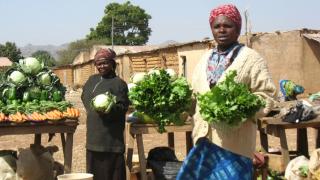
8
THE CLIMATE CRISIS IS A CATALYST FOR THE DECLINE IN FOOD SECURITY WE HAVE SEEN ACROSS THE CONTEXTS IN WHICH WE WORK SINCE 2017
Since we began measuring our data against the SDGs, we have noticed a gradual decline in food security. The contexts we work in have been severely impacted by drought and extreme heat. For programme participants in Iraq, the DRC, Nigeria and Rwanda, food security has been gradually declining since 2017 (this is despite consistent increases each year between enrolment and graduation).
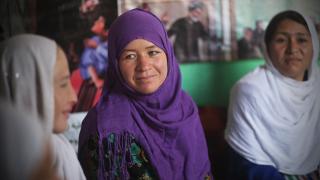
9
IN AFGHANISTAN, OUR DATA PAINTS A PICTURE OF WOMEN’S RESILIENCE AND DRIVE FOR THEIR OWN RIGHTS IN THE CONTEXT OF RISING INSTABILITY AND TENSION THROUGHOUT 2021
In 2021, before the Taliban takeover of Afghanistan, 100% of women enrolled on our programme had spoken out publicly against violence by the time they graduated. This is a significant percentage change from the other contexts in which we work and a huge rise from 18% at enrolment.
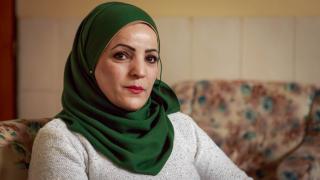
10
OUR FINDINGS EMPHASISE THE NEED FOR CONTEXT-SPECIFIC APPROACHES TO WOMEN’S RIGHTS IN FRAGILE AND CONFLICT AFFECTED COUNTRIES
Since 2018, the number of women reporting employment in Iraq has consistently stayed below 12%. In 2021, this figure was just 9%. While during 2020 and 2021 external factors such as COVID-19 lockdown measures likely had an impact on this, we reflected that some of this was a result of the economic context in Iraq being different to some of the other contexts where we implement our programme, the economic and cultural context is such that there are greater barriers for women to overcome than in our other countries.
We have therefore been working to adapt our programme in Iraq to ensure that women can sustain and grow both new and existing businesses. We’ve worked to strengthen the business start-up kit we provide women, plus explore amplified skill-building that prepares women for existing employment opportunities if self-employment is not possible or sustainable.
It’s time to take a holistic approach to women’s rights and SDGs.
At Women for Women International, our Stronger Women, Stronger Nations programme has consistently committed to building an enabling environment for women’s rights by not only supporting women to speak up alone but by ensuring she has allies and a community that will speak up with her. Working with the most marginalised women affected by conflict, we refuse to follow siloed approaches to gender equality because we know that women’s lives do not fit neatly into categories. Our commitment to this integrated approach through our one-year Stronger Women, Stronger Nations core programme - and the complementary Men’s Engagement and Change Agent programmes - is evidenced in the last five years of our programme graduate data, tracked across indicators that map to various SDGs.
The UN recently reported that without investment, gender equality will take nearly 300 years to achieve. External threats to gender equality are on the rise and we have a long way to go to achieve transformative change. However, it is not too late. As our data emphasises, holistically investing in every pillar of a women’s life can have a gender transformative impact across other key SDG metrics such as employment and earnings, human rights and social cohesion, education and food security. Closing the gender equality gap is not only fundamental for women’s rights or the measure of ‘gender equality’ captured in SDG5, but also for the implementation of ALL Sustainable Development Goals.
As our data shows, women are the change drivers of their own realities – listen to them, invest in them.
Keep reading
Following the UK Government's inquiry into extreme poverty, we set out the challenges the Government face to ensure their approach to extreme poverty meets the needs of marginalised women living in conflict-affected countries.
Our Global Advocacy Manager, Stephanie Siddall, discusses global progress towards gender equality and what more we must do to ensure that the most marginalised women and girls aren't left behind.
Interactive Dataset
subtitle:
Using the data we collect from our programme, we have created an interactive dataset to illustrate the impact of our programme on targets within the Global Goals.
Read the stories of women we serve
Nasima
subtitle:
Thanks to Women for Women International and my trainers, I now know how to sew beautiful dresses. Moreover, with the lessons I had about savings, I could save a portion of the stipends I was receiving from the programme to buy my own sewing machine.
Olga
subtitle:
If someone had told me in the past that I would need to restart my life from scratch, I couldn't believe it. But that is what happened to me when I needed to flee to Poland with my son.
Josephine
subtitle:
At 31 years old, Josephine is married with two children. She is from Nigeria, where she had to drop out of school after falling pregnant. Now, she hopes to continue her education to university level. Read her story.

